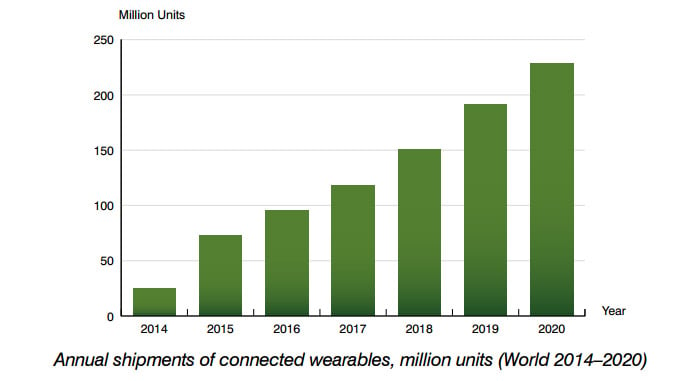Shipments of connected wearables reached 72.5 million in 2015 or 25.3 million devices more than in the previous year, according to a new report from Berg Insight. Growing at a compound annual growth rate (CAGR) of 25.8 percent, total shipments of smartwatches, smart glasses, fitness & activity trackers, people monitoring & safety devices and medical devices as well as other wearable devices are forecasted to reach 228.3 million units in 2020.
Bluetooth will remain the primary connectivity option in the coming years. Moreover, some 17.8 million of the wearables sold in 2020 are forecasted to incorporate embedded cellular connectivity, mainly in the smartwatch and people monitoring & safety categories.
Fitness & activity trackers represent the largest device category and shipments are expected to reach 51.0 million units in 2015.Smartwatch sales have picked up considerably during 2015 and shipments are on the track to reach 19.5 million units by the end of the year, a 353 percent increase year-on-year. “This market development has not gone unnoticed by the traditional watch industry and several vendors including Fossil and TAG Heuer have presented smartwatches of their own,” said Johan Svanberg, Senior Analyst, Berg Insight.
Today, fitness & activity trackers represent the largest device category and shipments are expected to reach 51.0 million units in 2015. Market pioneers such as Fitbit, Jawbone and Garmin have been joined by an abundance of companies including major players from the smartphone industry, like Xiaomi, Samsung and Microsoft. This product category is now facing fierce competition from smartwatches that in many cases include activity tracking features. Decreasing prices and new form factors will still enable dedicated fitness & activity trackers to reach shipments of 71.0 million units in 2020.
When it comes to connected wearables such as cardiac rhythm management devices, ECG monitors, mobile Personal Emergency Response Systems (mPERS) and wearable computers, they are already common in the medical, people monitoring and enterprise segments. And with further miniaturization of electronics, low power wireless connectivity and cloud services, the development of a wide range of new connected wearables has been enabled, including authentication and gestures wristbands, notification rings, smart motorcycle helmets and smart gloves.
Shipments of smart glasses have so far been very modest, but promising use cases in professional markets as well as in niche consumer segments will enable smart glasses to become a sizeable connected wearable device category in the next five years.


